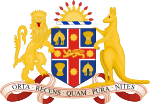Lindt Cafe siege

The Lindt Cafe siege was a terrorist attack that occurred on 15–16 December 2014 when a lone gunman, Man Haron Monis, held hostage ten customers and eight employees of a Lindt chocolate café in the APA Building in Martin Place, Sydney, Australia. The Sydney siege led to a 16-hour standoff, after which a gunshot was heard from inside and police officers from the Tactical Operations Unit stormed the café. Hostage Tori Johnson was killed by Monis and hostage Katrina Dawson was killed by a police bullet ricochet in the subsequent raid. Monis was also killed. Three other hostages and a police officer were injured by police gunfire during the raid.Police have been criticised over their handling of the siege for not taking proactive action earlier, for the deaths of hostages at the end of the siege, and for the lack of negotiation during the siege. Hostage Marcia Mikhael called radio station 2GB during the siege and said, "They have not negotiated, they've done nothing. They have left us here to die."Early on, hostages were seen holding a Jihadist flag against the window of the café, featuring the shahādah creed. Initially, many media organisations mistook it for the flag used by the Islamic State (IS); Monis later demanded that an IS flag be brought to him. Monis also unsuccessfully demanded to speak to the Prime Minister of Australia, Tony Abbott, live on radio. Monis was described by Abbott as having indicated a "political motivation," but the eventual assessment was that the gunman was "a very unusual case—a rare mix of extremism, mental health problems and plain criminality."In the aftermath of the siege, Muslim groups issued a joint statement in which they condemned the incident, and memorial services were held in the city at the nearby St Mary's Cathedral and St James' Church. Condolence books were set up in other Lindt cafés and the community turned Martin Place into a "field of flowers." The Martin Place Lindt café was severely damaged during the police raid, closed afterwards, then renovated for reopening in March 2015.
Excerpt from the Wikipedia article Lindt Cafe siege (License: CC BY-SA 3.0, Authors, Images).Lindt Cafe siege
Martin Place, Sydney Sydney
Geographical coordinates (GPS) Address Nearby Places Show on map
Geographical coordinates (GPS)
| Latitude | Longitude |
|---|---|
| N -33.867944444444 ° | E 151.21111111111 ° |
Address
Overseas Union Bank
Martin Place 53
2000 Sydney, Sydney
New South Wales, Australia
Open on Google Maps








